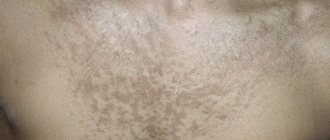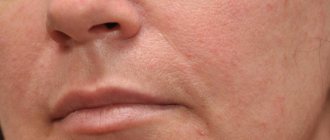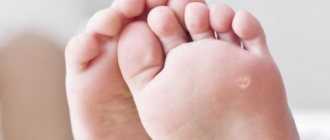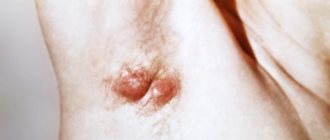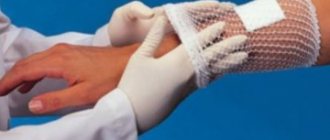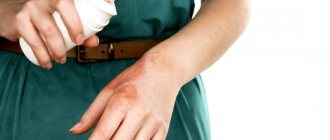Psoriasis, also called lichen planus, is a non-infectious chronic pathology that forms in the skin layer and manifests itself as peeling and rashes on its surface. The disease proceeds in waves - remissions are replaced by exacerbation of psoriasis, and it is necessary to understand what to do in such cases. Moreover, the disease can occur regardless of age, although young people are most often affected. Another feature of the disease is its progression over time; victims often note that during the next exacerbation, a larger area of the skin is affected.
Features of the appearance of exacerbations of pathology
Despite the fact that it has not yet been possible to determine the exact causes that provoke the formation of the disease, it has been possible to establish the mechanism of development. The basis for the formation of psoriatic rashes is a failure in the functionality of the immune system. As a result of disorders, immune cells begin to show aggression against skin cells, which leads to the formation of psoriatic lesions.
If we consider the causes of exacerbation of psoriasis, several typical points should be noted:
- Most often, the formation of psoriatic rashes during exacerbations is localized where the skin is thinnest and overdried or has been subjected to chemical and mechanical stress.
- The disease can become active as a response to almost any external influence, while the disease can worsen spontaneously, disappearing just as unexpectedly.
- Often, a situation where psoriasis worsens occurs during certain calendar periods. This is usually the winter season, although sometimes the condition may worsen in the summer. In addition, medicine knows a type of disease that does not depend on the season.
- It is possible that psoriasis may worsen after childbirth.
The duration of the exacerbation period can be several days or several weeks, but it is not possible to completely stop psoriasis.
Important. Therapy is carried out to achieve remission and is aimed at prolonging it in order to improve the quality of life. However, it will not be possible to eliminate the pathology from the body, nor will it be possible to get rid of its slow progression.
Stages of plaque psoriasis
Plaque psoriasis is differentiated depending on the area of the lesion, the speed of development and the severity of general symptoms.
- Mild degree: the extent of affected areas covers up to 3% of the body. Although the area of plaques may increase, the process subsequently stops, the rash becomes ring-shaped and disappears.
- Moderate (plaque) grade: plaques cover 10% of the skin. Papules, increasing in size, merge together, forming extensive inflammation and forming large plaques with scales. The affected areas are the areas above the knees and elbow joints, the lumbosacral region, feet, palms, and skin under the hair. The formations can have a color from pale pink to bright red. Externally, they are covered with grayish-whitish scales. Rashes in the present stage, when scratched or other provoking factors, occupy significant areas of the body.
- The severe form with 10% of skin lesions is characterized by the presence of plaques of significant size and irregular shapes. Plaques spread to the face, neck and limbs. With a long course of this form, which is called common, the affected areas become denser and swell. This is very noticeable in the lumbosacral region and on the buttocks. The disease progresses to the following, pustular, arthropathic form or psoriatic erythoderma with damage to the nails.
There are three stages of the psoriatic process:
- Active stage;
- Stationary;
- Regression.
The most common vulgar dermatosis has three stages: acute, stationary and regressive:
- During the acute period, the disease progresses: a papular rash appears, individual rashes merge into plaques, and the skin begins to peel off at the affected sites.
- The stationary period is characterized by intense peeling of the affected areas. A folded stratum corneum (the so-called Vorontsov's rim) forms around the plaques.
- At the stage of remission, plaques are eliminated independently; the skin at the site of which quite often has disturbed pigmentation.
During vulgar psoriasis there are three stages:
- Progressive.
- Stationary.
- Regressive.
Each of them has its own specifics.
What can cause an exacerbation of the disease?
There are many factors that may lead to an exacerbation of psoriasis requiring treatment:
- Intemperance in food preferences - abuse of salty, sweet and fatty foods, drinking alcohol and overeating in general can have a negative impact. Failure to follow a diet can also lead to worsening of the condition.
- Overstrain of a physical or emotional nature can have a negative impact.
- Household chemicals, new brands of cosmetics and perfume compositions do not have the best effect on the condition of unprotected skin.
- Another danger is vaccination and taking pharmaceuticals, usually antimicrobials, immunomodulators and some antidepressants, vitamin complexes, anticonvulsants and others.
- The condition can worsen as a result of smoking, in the presence of infectious, endocrine diseases, or the immunodeficiency virus.
The deterioration of the condition in women carrying a child, exacerbation in the postpartum period when breastfeeding, deserves special attention.
Possible reasons
The following factors can provoke an exacerbation:
- Changes in weather conditions. In most patients, signs of psoriasis appear at the same time of year. The most common winter type of the disease is aggravated by cold weather. The summer species is considered rarer. The third type of psoriasis occurs regardless of weather conditions.
- Abrupt climate change. Symptoms of autoimmune skin lesions may occur when traveling to hot countries in winter.
- Poor nutrition. If you have psoriasis, you should not eat fatty, sweet, salty or smoked foods. Characteristic plaques on the skin may appear after consuming large amounts of chocolate, coffee, confectionery, and products containing artificial flavors and dyes.
- Alcohol consumption. Ethyl alcohol negatively affects the liver and immune system, increasing the risk of autoimmune reactions.
- Psycho-emotional overload. Exacerbation of psoriasis can be facilitated by physical or nervous stress, participation in conflict situations, or the loss of a loved one.
- Exposure to chemicals. People suffering from psoriasis need to be careful when using cosmetics, household chemicals and medications.
- Vaccination. The introduction of viral vaccines is aimed at stimulating the immune system, which is why patients suffering from chronic autoimmune pathologies may increase the production of antibodies that destroy healthy tissue.
- Uncontrolled use of medications. Vitamins, antibacterial and immunomodulating agents, antidepressants, antiepileptic drugs and drugs for the treatment of psoriasis can provoke an exacerbation. The appearance of itchy plaques on the skin can be facilitated by the use of Kartalin, a herbal preparation for the local treatment of dermatoses.
- Infectious diseases. Psoriasis worsens against the background of sore throat, flu, ARVI and herpetic infections.
- Hormonal disbalance.
Why does the disease become more active during pregnancy and the postpartum period?
Quite often, psoriasis worsens after childbirth or before, during pregnancy.
According to statistics, in pregnant women with this disease, deterioration of the condition can be observed in 10-20%. True, at the end of the first trimester, in half of all cases there is a noticeable improvement. It was not possible to fully understand what exactly such changes are associated with, but it has been proven that actively produced estrogen together with progesterone act as immunosuppressants, and intensively produced cortisol has an anti-inflammatory effect. Important. According to medical statistics, it is enough to simply assume whether a woman carrying a child for the first time will suffer from an exacerbation of the disease, since in 87% of subsequent pregnancies the course of the previous one is repeated.
If there is a predisposition to pathological manifestations, constant monitoring by a doctor is necessary, which will avoid complications in the form of premature labor and malnutrition in the baby.
Hormonal changes overtake women not only after the start of pregnancy, but also in the postpartum period - the birth of a baby and subsequent breastfeeding can provoke a situation in which the accelerated development of psoriasis occurs.
As a result of studies in which 16 patients participated, the following facts were revealed:
- Severe exacerbation occurred in six cases.
- In eight cases, the course of exacerbation was of moderate complexity.
- Only in two cases did the disease not manifest itself after childbirth.
The main difficulty that arises when it is necessary to stop the exacerbation of psoriasis after childbirth is the almost complete impossibility of drug therapy, except in pathological cases. The reason is the high risk of pharmaceuticals passing into breast milk, and through it into the baby’s body.
Symptoms
Diagnosis of a simple form of the disease described is carried out when three symptoms appear and is carried out using a scalpel or other object that resembles it:
- Symptom of a “stearin stain”: when scraped, the scales are separated by shavings that resemble stearin;
- The presence of a terminal film, manifested by the opening of wet areas when scraped;
- Presence of droplets of blood when damaged.
In severe forms of the disease, changes are detected in blood tests (leukocytosis and increased ESR), which indicates biochemical and endocrine pathologies.
The disease generally develops gradually, although an acute onset is possible. The first manifestations of simple psoriasis are the appearance of pink or red papular rashes on the skin.
These are dense limited nodules that rise above the surface of the skin, covered with grayish-white scales on top. Peeling may not be observed on all elements, but it is easily detected when scraping the surface of the papules.
The rashes are not abundant and are localized in the same areas for a long time. This could be the skin over large joints, the scalp, etc.
The disease can have varying degrees of severity. Their determination is based on a number of factors:
- affected areas;
- degree of activity of the pathological process;
- the presence of general symptoms: fatigue, increased ESR, increased uric acid levels.
In the case of a mild course, when the affected areas occupy up to 3% of the skin, the rash increases slightly in size, after which the pathological process stops and the rash begins to gradually disappear: the central part of the papules turns pale, then they acquire a ring-shaped shape and soon become completely invisible.
With moderate severity of the lesion, the number of rashes increases, psoriatic elements spread to 3-10% of the skin. Primary papules gradually increase in size, are located in groups, merge with neighboring ones, resulting in the formation of large plaques with a scaly surface.
A plaque form of vulgar psoriasis develops. Most often, the affected areas are the areas above the elbow and knee joints, the extensor surfaces of the upper and lower extremities, and the lumbosacral area.
Plaques can also be located on other areas, including the scalp, plantar surface of the feet, and palms.
The color of psoriatic lesions varies from pale pink to deep red, and their surface is covered with grayish-white scales. As a result of exposure to provoking factors - microtraumas, scratching, poor nutrition - the rashes spread over large areas. Exacerbation of psoriasis often occurs in winter.
When the affected area is more than 10% of the entire skin, we are talking about a severe course of ordinary psoriasis, which is called widespread. In this case, plaques often acquire irregular, bizarre shapes, spreading to the lower and upper limbs, torso, neck and face.
With a long course of widespread vulgar psoriasis, pathological elements often swell and thicken, especially when located in the lumbar and gluteal regions. Factors such as severe stress, severe infection, an allergic reaction to medications can cause a significant spread of the psoriatic process and the sudden appearance of itchy, swollen, bright red elements over the entire surface of the skin.
In the absence of treatment or improper therapy, the pathology progresses. Psoriasis can take a chronic course, but in most cases it occurs in waves: relapses are followed by periods of remission.
In some cases, the disease may progress to a severe form: arthropathic, pustular or psoriatic erythroderma. It is also possible to develop psoriatic onychodystrophy, accompanied by damage to the fingernails or toenails.
The presence of obesity, immune and endocrine disorders in the patient can cause the plaques to ooze, with the scales becoming yellowish-gray in color and greasy, and can stick together and stick to the surface, forming psoriatic crusts.
The so-called exudative form of widespread psoriasis develops. It is often diagnosed in older people and children, as well as in people who work outside during the cold season.
Vulgar plaque psoriasis usually begins to develop gradually. In this case, small red areas of a papular nature appear on the body. In appearance, these spots resemble small nodules that are covered with gray scales.
Such rashes can appear only on certain areas of the skin, such as the elbows, back or legs, or spread throughout the body. In addition, they can merge with each other, forming large plaques.
How can you prevent an exacerbation?
Undoubtedly, the main therapeutic regimens in order to relieve an exacerbation of psoriasis should be developed by the attending physician.
But the patient himself, adhering to a list of certain recommendations, can improve his own condition in many ways:
- The daily menu needs to be adjusted.
- Focus on regular cleansing of the body.
- Work on restoring the balance of intestinal microflora.
- Improve the condition of the immune system.
- Try to avoid stressful situations.
In the event that an exacerbation does occur, the use of pharmaceutical drugs should be prescribed exclusively by the attending physician, especially since proper therapy to quickly relieve an exacerbation of psoriasis is a complex measure.
Use of pharmaceutical drugs to relieve exacerbation
Drug treatment of psoriasis during its exacerbation should be comprehensive and include antihistamines and sedatives, agents that allow cleansing the body, restoring the balance of intestinal microflora and strengthening the immune system. In some cases, hormones may be prescribed.
Let's talk in more detail about what medications the attending physician can prescribe:
- If the cause of aggravated psoriasis is stress and excessive anxiety, it is necessary to take sedatives, which include tinctures of Motherwort and Valerian, as well as the very effective drug Novopassit.
- Antihistamines, which include Suprastin, Cetrin, Claritin and others, will help eliminate inflammatory processes and reduce the itching that accompanies the appearance of psoriatic plaques.
- To cleanse the body of toxins and prevent subsequent relapses, Enterosgel, Sorbex, Smecta or inexpensive activated carbon can be taken.
- You can normalize metabolic processes with the help of Linex or Bifiform, which help restore the intestinal microflora.
- Considering that quite often exacerbations occur due to a weak immune system, therapy includes taking Folic acid, which allows the regeneration of damaged skin, vitamin complexes and mineral supplements.
Often the condition worsens while taking antimicrobial drugs; in this case, it is not enough to stop using them. You may need to use Celestoderm, which quickly relieves itching, Elokom, intended to heal delicate areas, Dovonex to eliminate inflammation and redness, and Salicylic ointment to moisturize the skin.
What to do
The best solution to this issue is an immediate visit to a specialist doctor who will advise and prescribe all the main points of stopping the exacerbation. However, there are a number of simple techniques that can minimize the manifestations of the disease.
To relieve symptoms you need:
- Minimize the stress impact on the patient, help him feel the joy of life;
- Completely review the patient’s menu in the direction of its optimization;
- Cleanse the body and support your own microflora;
- If necessary, carry out a set of procedures with antihistamines.
Of course, all this is easy to say, but very difficult to do. And yet, everyone is quite capable of adjusting their daily routine, setting aside time for daily walks and guaranteed healthy sleep. Everyone can reconsider their attitude towards alcohol, tobacco and fatty foods. To cleanse the body, it is not at all difficult to take drugs such as activated carbon, Smecta or Enterosgel and Sorbex.
Sorbents will help get rid of unnecessary and often toxic substances for the body, which will significantly facilitate the work of the immune system and its forces will be directed to a greater extent towards normalizing the situation with psoriasis. After cleansing the body, it will not be superfluous to put the state of the microflora in order. For this purpose, drugs such as Linex, Bifidumbacterin, Bifiform are suitable.
How to relieve exacerbation of psoriasis using local therapy
Local treatment can relieve exacerbation of psoriasis at home; moreover, it can be prescribed for young patients and nursing mothers. The purpose of this therapy is to eliminate redness and itching; the creams, gels and ointments used have an antiseptic effect and stop inflammatory processes. Also, such products accelerate the exfoliation of scales and improve the regeneration of skin cells.
Among pharmaceutical preparations, the most popular are Zinc, Salicylic and Sulfur ointments, preparations based on grease and tar. For the treatment of psoriasis on the scalp, Nizoral, Ketazoral or Sulsena, their analogues, are prescribed. Ointments based on birch tar can also be prepared at home, since additional treatment for exacerbation of psoriasis can also be carried out using traditional medicine recipes.
To prepare the product it is recommended:
- Take two big fly in the ointment.
- Add a large spoonful of butter to them (it is best to use a homemade natural product for this purpose).
- Add ½ small spoon of copper sulfate to the mixture.
- The mixture should be stirred and boiled over low heat, stirring constantly.
The resulting ointment is poured into an enamel container and stored in a cool place, regularly applied to problem areas.
Prescription of physiotherapeutic measures and diet
In case of severe exacerbation and ineffectiveness of local treatment, physiotherapeutic procedures are prescribed:
- To reduce the activity of immune cells, phototherapy is prescribed, in which the effect is carried out using ultraviolet rays.
- To reduce inflammatory processes, cryotherapy is prescribed, used either in areas where the process is localized, or applied to the entire surface.
- Treatment with leeches shows a good effect in case of exacerbation of psoriatic arthritis.
- A doctor may recommend a trip to a resort, since the beneficial effects of the sea climate and sunbathing have been proven.
- Magnetic therapy, laser treatment, and electrophoresis using glucocorticosteroids may also be prescribed.
As for diet, general principles include fractional meals, proper cooking, in which it is preferable to boil or steam dishes. Vegetable fiber must be present in the diet. Proper drinking regimen is also important - the amount of liquid consumed should not be less than two liters during the day. You will have to give up alcoholic drinks and start losing weight if necessary.
Also, in case of exacerbations, it is recommended to use elimination, whose principle is the gradual elimination of inappropriate products from the menu, which makes it possible to identify elements that provoke the development of exacerbations.


